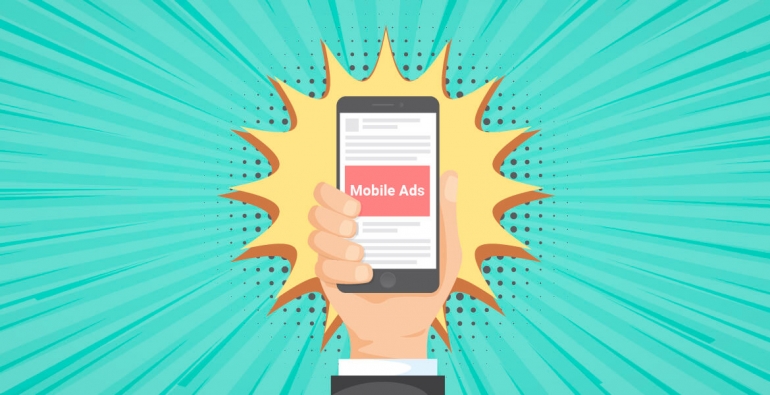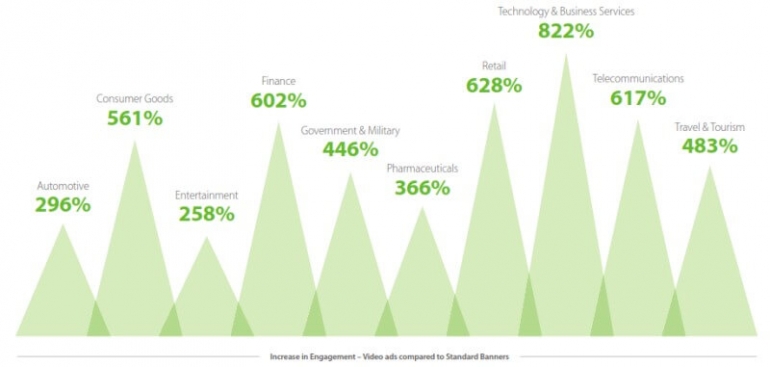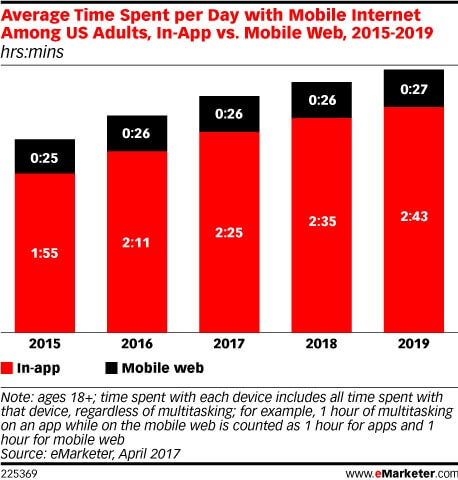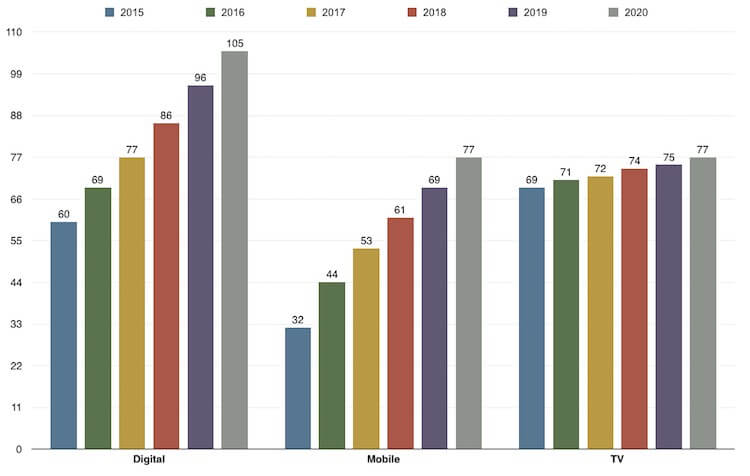Mobile ads are dominating display advertising so, being present in the mobile ad network is a marketing strategy almost every business should know about.
What Are Mobile Ads?
The definition of mobile ad, according to Google Ads support is “A type of ad that can appear on web pages and apps that are viewed on a mobile device like a cell phone or tablet. For Google Ads, “mobile” is defined as where the ad can appear on “mobile” devices. These include high-end mobile devices with smaller screens, such as smartphones.”,
This is the simplest and most comprehensive definition I have ever come across with and I am sure it leaves no question unanswered.
The History of Mobile Advertising As The Mobile Networks Evolved
But how mobile ads became so important today? Let’s get back to the basic.
A decade ago, when smartphones were almost a cutting-edge idea, nobody would have expected that in just a few years, these devices will become indispensable to us. Nobody would have expected that they will take over the Internet, social media and the way we share and read our news.
“As of February 2017, mobile devices are accounted for 49.74 percent of web page views worldwide”, Statista.com writes.
You cannot ignore the power of mobile and the time people spend browsing on their smartphones and tablets.
Almost half of the online traffic comes from mobile devices. Therefore, any marketing or advertising campaign should also focus on them.
Moreover, 51% of all digital advertising budgets were spent on mobile ads in 2016.
By 2019, it is expected that 72% of all US digital advertising budgets will be spent on mobile ads. Since 80% of all Internet users own a smartphone, the rise of the mobile ads industry is quite obvious.
Considering these stats, let’s get back to our main topic and analyze the mobile ads industry.
Mobile Marketing Strategy
Apart from these three main mobile ad formats, your strategy should also be based on a marketing strategy which can include one, two or all three types of mobile banners.
Here, you can include a social media presence, native apps and of course, influencer marketing strategies if you find out they can be suitable and profitable for your business, brand or products.
How mobile ads work
As I have already stated, mobile advertising consists of ads being placed on mobile devices. Their visual styles differ, so do their formats. Also, there are several channels where you can publish mobile ads, starting with the apps and up to the social media platforms.
Mobile ads for publishers
Mobile advertising is a two-way street. There are always two parties involved and they benefit together from the ads delivered to the audience. While advertisers serve ads in order to grow engagement, get leads, convert leads to customers or grow awareness of their brand, publishers use ads to monetize their websites and apps. If you are also a publisher and you are reading this article, here you will find an exhaustive list of the most popular and probably the best 25 ad networks you can work with.
Mobile Ad Types by Formats
There is no single mobile ads design, as there are many types of advertising banners and ads for mobile, depending on what your strategy is and how you wish to implement it.
If we’d break down them into simple categories, the whole picture will look similar to the following subchapter:
A. Mobile banner
This is the most popular form of advertising on mobile devices. In most of the cases, banners are displayed in unobtrusive places, at the top or at the bottom of a web page or an app and display relevant texts or graphics. Banner campaigns rely mostly on brand recognition and brand awareness since the space is very limited and there is not enough room for detailed information to be displayed. However, the goal is to present the brand or product name to as many people as possible and convert them into customers or at least leads.
B. Native mobile ad
A native advertising strategy relies on banners that don’t actually look like banners. They are less intrusive because they are integrated into the publisher’s app. They look and feel similar to any other page of the original application. Thus, they aim to a better user experience.
C. Mobile video ad
This is a type of mobile advertising that resembles mostly the native ad because it usually plays when the user interacts with a specific application. They are simple when it comes to the concept but harder to make. You need professional designers and video editors in order to create a catchy ad and of course, a bigger budget and more time. Regardless of the costs, however, they are a good choice due to the fact that they can deliver a 5x higher engagement rate than that of the standard banners.
Mobile Ad Types by Serving Channels
How are mobile ads served?
Both publishers and advertisers may benefit from the following main types of ads and ad serving channels:
1. Mobile apps ads for engagement and conversion
People spend more time on apps than on any other mobile-related activities. Click To Tweet According to Emarketer, mobile apps account for almost 85% of total mobile time spent by the average user. The same report states that an adult spends on average at least 25 minutes every day using mobile apps. This means that the apps are (and should be) the main focus of a mobile marketing strategy.
The mobile ads for apps are usually based on native advertising and are considered less intrusive than banners. You can easily integrate static or video ads into the pages of an app and deliver them when the user starts the application, before closing it or in between, from time to time.
There are services like AdMob from Google, that help advertisers create and deliver their ads to third-party apps. However, you can also create ads and integrate them with Facebook’s mobile app through their own advertising platforms. Promoted post ads will serve you best if you want to publish on a social media platform and a mobile app at the same time.
2. In-game mobile ads for gamers and young audiences
Another way of conducting marketing on mobile devices is by delivering ads that appear within mobile games. You can choose to publish full-screen video ads or mobile banner ads to appear when the user reaches specific loading screens.
3. Location-based mobile ads
These ads are set up to appear on the users’ mobile devices based on their location and in relation to a specific area or business. For example, there are advertisers who want their ads to be displayed when someone enters the area where their business is located, within a specific radius. Or, there may be advertisers who want to target users when they enter a specific shop, neighborhood or city.
4. Mobile search ads
These ads are similar to desktop Google ads. The only difference is that they are built and adapted for mobile use.
5. SMS marketing
Finally, there is yet another method of conducting marketing on mobile devices. The SMS marketing strategy involves sending text messages to a list of phone numbers, clients, or non-clients.
While some might think it’s obsolete, SMS marketing is making a huge comeback in the digital space. In fact, marketing automation campaigns earn a 47.7% higher conversion rate when including SMS marketing.
How to Place Mobile Ads – 3 Steps
There are many variables upon which your success depends when you deal with mobile ads. Starting with the size of the banner and up to the demographic selection, everything counts. Let’s take a quick look at every option you have and talk about why it matters to your campaign:
Step 1. Choose the best format and size for your brand and/or company
There are several mobile ad sizes to choose from but take into account that above anything else, you need not to be intrusive. If you choose full-screen videos on apps and games, there will be no issues on this part. However, if your choice is mobile ad banners, then you should be very careful not to annoy and intrude your potential customers with oversized banners and disruptive messages.
In conclusion, the best and most suitable mobile banner ad sizes are those who do not interfere with your audience’s mobile browsing experience. Why? The larger the ad, the more it limits the view area of the user.
Step 2. Avoid creating false footers/ends for the user
Big banners on mobile devices may also disrupt the users by giving them the impression their reading session is over. What does this mean?
Well, if you place a banner in the middle of an article, if the mobile banner is wide and very big in height, it may lead the viewer to think that it marks the end of the article and as a consequence, disrupt their entire experience on that specific site.
Step 3. Design the right display ads for your campaign
When you think about placing your mobile display ads, you should also take into account the mobile ad design. As I have already said, a large mobile banner may disrupt the viewers browsing experience and therefore, you should consider adjusting its size so that it won’t be intrusive. You can also design full-screen ads to be placed on apps or games. Bannersnack is the right mobile banner maker that will help you avoid any issues at this point and deliver beautiful and attractive mobile web ads to your audience. All you have to do just Sing Up and you are ready to design professional ads.
How to Track Mobile Ads
One of the most important steps in mobile advertising is to track your ads and adapt to your targeted audience’s behavior. Usually, every advertising platform has its own analytics built-in feature. You won’t need to worry about this part.
However, I would recommend you to also use your own website analytics and analyze or compare the results. Also, it will help you to use an URL builder in order to generate custom campaign parameters for your URLs. You can find a list of builders for Google here. Facebook also offers a similar feature that you can access and evaluate here.
How Much Do Mobile Ads Cost? Bidding Options
There are several ways in which you can choose to pay for your mobile banner ads campaign. However, the most popular two methods of tracking your expenditures are via CPC CPA or CPM.
CPC (Cost per click)
Most of the advertising networks will let advertisers bid for their CPC. The smaller the niche you choose, the higher will be the price of every click you will receive on your mobile web ads. According to Wordstream, the average CPC on Google’s Adwords is $2.32 across all industries. The same source suggests that the average CPC on Facebook is just $1.72.
CPA (Cost per action)
When it comes to mobile ads, clicks are not always what you expect from an advertising banner or video ad especially if you are looking to get conversions. If you are building your campaign based on how many people installed or downloaded an app, requested quotes from you or signed up for your services, you may need a CPA bidding method. This option has, however, a downside: There are only a few potential customers who will take action immediately after they first see a video or other types of mobile display advertising banners.
“By only charging for actions, and not impressions, the advertiser doesn’t have any sense of which touchpoints led to the final consumer action”, Cameron Fitchett, marketing manager at Gimbal writes.
Here, the costs depend on your niche and of course, on how attractive is your banner or video ad. You can calculate your average CPA by dividing the total costs for a campaign to the exact number of conversions or the number of paying/interested/signed-up customers.
CPM (Cost per mille – cost per thousand impressions)
When you are bidding for impressions, you pay for people who see your mobile ad and not for clicks or actual conversions. However, this method of bidding is still popular and presents various benefits for the advertiser. Not all banners are focused on immediate conversion or an action. Depending on the type of your campaign, especially if you are aiming to grow awareness on your brand, impressions may prove to be relevant and easily countable.
According to Mobyaffiliates, an advertising company specialized in mobile marketing, the average CPM for an advertisement placed in mobile apps is $4. The same source values the average mobile video ad CPM at $3 and the mobile banner ad CPM at $1.
Benefits of Using Mobile Ads (Are Mobile Ads Profitable or Not?) ROI vs ROAS
As I have already said in the preview of this article, mobile devices are accounted for almost half of the total page views online. This means that when it comes to advertising, mobiles should be for marketers at least as popular as desktops.
Therefore, if the average online advertising campaign gets to be profitable if it is set up correctly, a mobile campaign should deliver similar results.
What are the benefits of mobile advertising?
- Accessibility. People are now tied to their smartphones. They keep them at hand when they are at home; they use them when they are away, at the office, during holidays, at the bars and restaurants, etc. Through mobile ads, you’re just a few seconds away from your audience.
- A diverse and wide audience. There’s a huge number of mobile users and it keeps growing with every new year that passes. People of all social backgrounds, of all ages and ethnicities, are using now smartphones and tablets wherever they are, several times a day, browsing, reading, staying informed.
- Costs. Obviously, mobile advertising costs a fraction of what radio, television and print media ads cost. Moreover, you can reach more people with less money, as you can target your ads based on various variables such as geographical area, age, social status etc.
- Native apps. People who spend their free time on smartphones are already used with mobile apps. A dedicated app may cost you a little more than traditional online advertising but it may prove to be quite successful, especially if you run an eCommerce website. The shopping experience is better via a dedicated app than through the web browser.
There are two important metrics used to gauge the profitability of your mobile ad campaigns: ROI – return on investment and ROAS – Return on Advertisement Spend. ROI measures the profit generated by ads vs their cost while ROAS represents the efficacy of a campaign. ROI is business-centric while ROAS is advertiser-centric.
Four Examples of Successful Mobile Ad Campaigns
Before concluding this article, let’s take a quick look at some of the best and most successful mobile advertising campaigns that we have seen over the past few years.
- Nissan – The interactive video ad
Nissan was one of the first companies that showed us how to exploit the unique features of a mobile device, for a successful marketing campaign. In this specific case, the unique feature I am talking about is the touchscreen. The video ad was engaging and entertaining at the same time, with evil snowmen attacking and battling with a compact Nissan SUV. The ad also presented some interesting hotspots where the user was able to tap the screen in order to get important information about the car’s features.
According to mmaglobal.com, “the 60-second video garnered a 78 percent completion rate and a 93 percent engagement rate”.
- Hiscox – Location-based tracking campaign
One of the best features of mobile advertising is that you can serve ads based on your audience’s location and thus, target people who are close to your shop, office or quarters. In this case, the example comes from Hiscox, an insurance company. Their ad targeted a specific group of people that lived in Covent Garden. How did it work? Each time they logged in to a Wifi hotspot in that area, they were greeted with the Hiscox ad. The results? The click-through rate was 5 times higher than the company received on other display ads.
- Airbnb’s, „Don’t go there, live there” campaign
The list of the best mobile ads continues with yet another video banner launched by Airbnb. This example shows us how a great call to action, paired with a good and entertaining video, can make an advertising campaign successful. The ad focuses on what makes Airbnb different from other similar services, including hotels, and what makes this „different” better for people who like to travel. The results?
This video ad only managed to get 18 million views as of January 2018 and we are still counting.
- Cosmopolitan – „Just the right amount of wrong” campaign
This campaign was set up for „Cosmopolitan” hotel and casino of Las Vegas. The goal was „to create an immersive experience that piqued curiosity about this vacation destination where your vices are our virtues.” The result?
The „canvas” ad reached out to 35 million users which spent an average of 29 seconds exploring it. The campaign lasted for 4 weeks during which time 200 reservations were made online.
Conclusion
Mobile display ads are a great way to conduct marketing online
…considering that smartphones and tablets are being used daily by most of today’s people. Whether you choose to display banners, videos or to create your own dedicated apps for specific campaigns, you should always take into account not only your goals but also your audience.
There are some great examples of successful campaigns you can get inspired from but most of all, you should find inspiration in your own brand and values.
What do you think about mobile advertising and what types of display ads did you use on your own campaigns?










Wrong Weather Voucher
January 23, 2018This is a really excellent tip which help the business grow and to increase our client as well thanks soo much this mobile tips.
Thomas
June 10, 2019Great post. mobile ads are proving to be one of the key strategy for business who are looking to grow their business digitally.
julesjohn
September 4, 2019I literally had wonderful time reading all of these details.
Good Post! Thank you so much for sharing this pretty post, it was so good to read and useful to improve my knowledge about mobile video advertisement. After reading your article i would decide to promote my business via djax technologies mobile adserver campaign .
Amar V
November 5, 2019Your blog shows the informative content. Thanks for sharing! Get good knowledge from it.
Mark Taylor
March 5, 2020A great read indeed! I came across a very interesting mobile advertising tool called moLotus.
Anousheh
June 3, 2020Good blog about mobile display advertising it is great for online marketers who wants to run paid ads in Google.